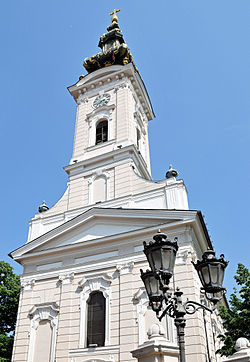
Sremski Karlovci is a town and municipality located in the South Bačka District of the autonomous province of Vojvodina, Serbia. It is situated on the banks of the Danube, 8 kilometres from Novi Sad. According to the 2011 census results, it has a population of 8,750 inhabitants. The town has traditionally been known as the seat of the Serbian Orthodox Church in the Habsburg Monarchy. It was the political and cultural capital of Serbian Vojvodina after the May Assembly and during the Revolution in 1848.
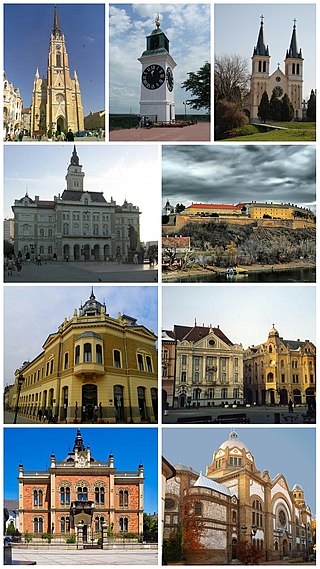
Novi Sad is the second largest city in Serbia and the capital of the autonomous province of Vojvodina. Novi Sad is home for 367,121 inhabitants. It is located in the southern portion of the Pannonian Plain on the border of the Bačka and Syrmia geographical regions. Lying on the banks of the Danube river, the city faces the northern slopes of Fruška Gora.

Vojvodina, officially the Autonomous Province of Vojvodina, is an autonomous province that occupies the northernmost part of Serbia. It lies within the Pannonian Basin, bordered to the south by the national capital Belgrade and the Sava and Danube Rivers. The administrative center, Novi Sad, is the second-largest city in Serbia.

Petrovaradin is a historic town in the Serbian province of Vojvodina, now a part of the city of Novi Sad. As of 2011, the urban area has 14,810 inhabitants. Lying on the right bank of the Danube, across from the main part of Novi Sad, it is built around the Petrovaradin Fortress, the historical anchor of the modern city.

Sombor is a city and the administrative center of the West Bačka District in the autonomous province of Vojvodina, Serbia. The city has a total population of 47,623, while its administrative area has 85,903 inhabitants.

Bačka or Bácska is a geographical and historical area within the Pannonian Plain bordered by the river Danube to the west and south, and by the river Tisza to the east. It is divided between Serbia and Hungary. Most of the area is located within the Vojvodina region in Serbia and Novi Sad, the capital of Vojvodina, lies on the border between Bačka and Syrmia. The smaller northern part of the geographical area is located within Bács-Kiskun County in Hungary.
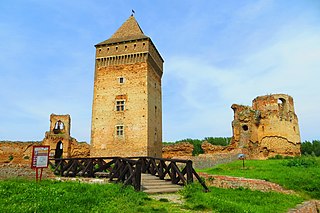
The South Bačka District is one of seven administrative districts of the autonomous province of Vojvodina, Serbia. Geographically it lies in the southern part of Bačka and northern part of Syrmia. According to the 2011 census results, it has a population of 615,371 inhabitants. The administrative center of the district is the city of Novi Sad, which is also the capital and the largest city of the Autonomous Province of Vojvodina.
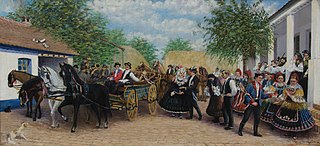
Bački Petrovac is a town and municipality located in the South Bačka District of the autonomous province of Vojvodina, Serbia. The town has a population of 7,452, while Bački Petrovac municipality has 13,418 inhabitants.

Sremska Kamenica is a town and urban neighborhood of Novi Sad, in Serbia.
Vojvodina's demographic history reflects its rich history and its former location at the border of the Ottoman and Habsburg empires and at the confluence of various peoples, making it a hotbed of invasion, colonization, and assimilation processes. Currently there are more than 25 ethnic groups living in Vojvodina and six official languages.
Podunavlje is the name of the Danube river basin parts located in Serbia and Croatia. Podunavlje is located on the southern edge of Pannonian Basin. In its wider meaning, the Serbo-Croatian term refers to the area around the entire flow of the river Danube.
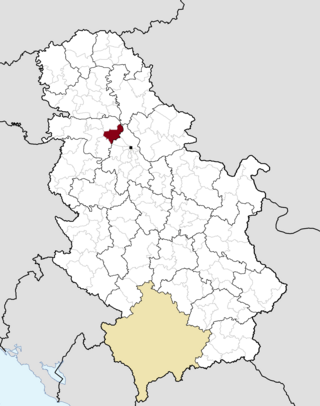
Stara Pazova is a town and municipality located in the Srem District of the autonomous province of Vojvodina, Serbia. The town has a population of 64792, while Stara Pazova municipality has 65,792 inhabitants. The entrance into town from Inđija lies on 45th parallel north, it is half-way between the North pole and the equator.
Vojvodina is an autonomous province that comprises northern Serbia. It consists of the southern part of the Pannonian Plain, mostly located north from the Danube and Sava rivers.

The Serbs of Vojvodina are the largest ethnic group in this northern province of Serbia. For centuries, Vojvodina was ruled by several European powers, but Vojvodina Serbs never assimilated into cultures of those countries. Thus, they have consistently been a recognized indigenous ethnic minority with its own culture, language and religion. According to the 2011 census, there were 1,289,635 Serbs in Vojvodina or 66.76% of the population of the province.

Serbia has been traditionally a Christian country since the Christianization of Serbs by Clement of Ohrid and Saint Naum in the 9th century. The dominant confession is Eastern Orthodoxy of the Serbian Orthodox Church.
According to the 2011 census, Slovaks in Serbia number 52,750, constituting 0.7% of the country's population. They mainly live in Vojvodina (50,321), where they constitute the third largest ethnic group after Serbs and Hungarians. Like other ethnic Slovaks, they speak the Slovak language, but most of them are Protestant by faith and not Roman Catholic, unlike most Slovaks in Slovakia.
Protestants are the 4th largest religious group in Serbia, after Eastern Orthodox Christians, Roman Catholics and Muslims. In the 2011 census, there were 71,284 Protestants in Serbia and they comprised 1% of the population of the country. Ethnic Slovaks constitute majority of Serbia's Protestant community. Some members of other ethnic groups are also adherents of various forms of Protestant Christianity.

Muftiship of Novi Sad is one of the four muftiships of the Islamic Community in Serbia. Muftiship is including territory of the Autonomous Province of Vojvodina and its seat is in Novi Sad. Administrator of the muftiship is mufti Fadil Murati.

Christianity is the predominant religion in Serbia. The Constitution of Serbia defines it as a secular state with guaranteed religious freedom. Eastern Orthodox Christians comprise 84.5% of country's population with 6,079,396 members. The Serbian Orthodox Church is the largest and traditional church of the country, adherents of which are overwhelmingly Serbs. Public schools in Serbia allow religious teaching, most commonly with the Serbian Orthodox Church. Serbian public holidays include the religious celebrations of Eastern Orthodox Christians. Other Orthodox Christian communities in Serbia include Montenegrins, Romanians, Macedonians and Bulgarians. The Catholic Church is prominent in north Vojvodina amongst the Hungarian minority. Protestantism is most largely found in Slovak populations within Bački Petrovac and Kovačica. Christianity first arrived in Serbia in the 9th century. It became state-religion in the 9th century when Serbia began to identify as a Christian country. In a 2011 census, 91.22% of Serbians identified as Christian.

